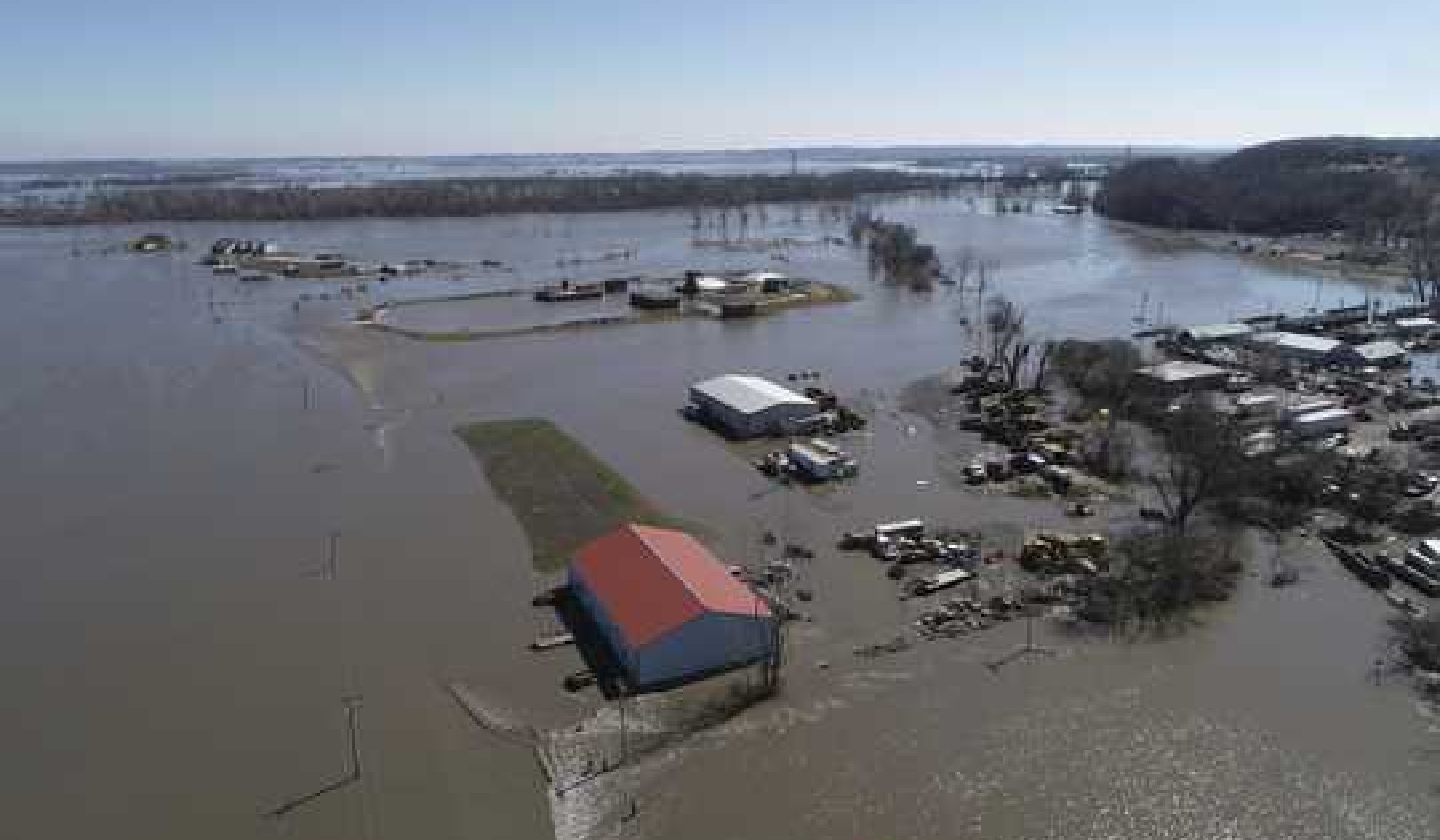
Image by Merio
(Editor's Note: This article is excerpted from Restoring the Earth, a 1997 book, thus the statistics are not current, but unfortunately the problem still is.)
When biologists speak about Cleopatra's bathwater, what they are playfully illustrating is that the Earth is mainly a closed loop. What's here today was generally here yesterday. So that cup of tea you're drinking could once have been Cleopatra's bathwater!
But if Cleopatra were to bathe in the Earth's waters today, her skin would crawl and palace heads would roll. Our booming human population is massively disturbing the planetary waters, polluting and straining the ecology of water everywhere.
Water and oxygen define the blue-green Earth as a "water planet", in Jacques Cousteau's lovely image. The human body, which is 97 percent water, can survive longer without food than without this vital liquid. Yet freshwater available for human use constitutes less than half a percent of all water on the planet, and represents an increasingly scarce and threatened resource. Even the once seemingly endless seas are beleaguered.
As water wizard Peter Warshall has written, "Life depends in toto on water's constancy. (Technically, this is one aspect of an organism's homeostasis.) The ability of water to absorb large amounts of energy, buffers photosynthesis in cytoplasm and the transfer of oxygen in animal blood from chaotic flux; moderates the Earth's climate by using oceans and lakes for heat storage; eases seasonal change and our bodies' adaptation to it by slowing, without shocks, the change of weather; and protects plants like cacti from boiling under desert skies.
Most of all, water's specific heat, heat of vaporization, and heat of fusion give life its ability to maintain itself in hard times. Without these molecular traits, climatic extremes would turn living creatures over to their Maker at unprecedented rates."
Water Has Been Held Sacred
Water has been held sacred by virtually all the world's religious and spiritual traditions. As Chinese sage Lao-Tzu long ago observed,
"The sage's transformation of the world arises from solving the problem of water. If water is united, the human heart will be corrected. If water is pure and clean, the heart of the people will readily be unified and desirous of cleanliness. Even when the citizenry's heart is changed, their conduct will not be depraved. So the sage's government does not consist of talking to people and persuading them, family by family. The pivot is water."
Our very life originates in the water of the womb. Yet we have treated it as hardly more than an industrial "resource" and noxious dumping ground. We are learning that we cannot live without this precious substance, but it seems that perhaps we have had to defile this sacred essence of life in order to learn our intimate dependence on it, and to undertake the restoration of the world's waters.
THE PROBLEM
We are witnessing the disastrous effects of toxic agricultural and industrial practices, uncontrolled development, urban growth, "heroic" engineering projects that dam or divert nearly all rivers, and rapacious overfishing. Sewage and toxic chemicals poison rivers, lakes, coastal areas, and even the high seas, introducing virulent toxins into the global food chain. About 80 percent of diseases are transmitted by water.
Aquifers that provide drinking water are falling, and wetlands are disappearing. Irrigated lands are declining in productivity and being lost to salinization. Fisheries are collapsing. Conflicts among nations and groups over-access to shared rivers or fisheries are escalating, creating serious prospects of water wars.
Finally, global warming is a potential source of great instability if marine currents, rainfall, coastal flooding, and weather undergo as significant a shift in pattern as anticipated by many scientists. The nation of Holland is examining the feasibility of constructing a huge offshore dike to offset flooding in case global warming causes an expected rise in ocean levels! The entire state of Florida is near sea level, and even a small rise in the oceans could deluge it and innumerable coastal areas worldwide.
Global water use has quadrupled since 1940, but it is very unevenly distributed. Average per capita U.S. use (the highest in the world) is 7,200 liters a day; and in India it is 25 liters. Around the world, water tables are falling: in Bangkok, they have fallen some eighty feet since 1958, and continue dropping some 12 feet a year; in Tamil Nadu, India, they have fallen some hundred feet in the last 20 years
The giant Ogallala aquifer in the U.S. Central Plains, supplying 20 to 30 percent of all U.S. irrigation water, has been severely depleted, forcing major reductions in irrigated acreage especially in Texas. China, with 22 percent of the world's population but only 8 percent of its freshwater supply, is now the world's fastest growing economy. But Beijing, Tianjin and the North China Plain are all facing very serious water shortages.
At least 26 countries are now considered "water scarce". Many of them are in the Middle East and Africa, with rapidly rising populations in already politically volatile regions, and they share with several neighbors river basins that are virtually their only source of water. In fact, 40 percent of the world's population lives in river basins shared by more than one nation.
In the Third World, at least 1.5 billion people lack access to unpolluted drinking water. The resulting diseases kill millions annually (up to 25,000 a day). About 70 percent of India's water is polluted, and 41 out of 44 of China's large cities have polluted groundwater.
Recent studies link chlorine, the very chemical used to disinfect water, to cancer. Sporadic crises erupt in urban water supplies -- Milwaukee's infamous 1993 cryptosporidium outbreak, New York's scare that same summer, and high lead levels in many municipal water systems.
The Natural Resources Defense Council (NRDC), a nonprofit environmental watchdog, found 250,000 violations of the safe water drinking act in 1991-1992, when 43 percent of the nation's water systems had violations. A U.S. Public Interest Research Group (PIRG) study found 21 percent of the nation's largest industrial and public waste treatment facilities in chronic serious violation of their discharge permits, and another 19 percent with occasional violations. In 1993, some 31 states reported concentrations of toxic contaminants in freshwater fish tissues that exceeded public health standards.
The damming and diverting of nearly every major watercourse on Earth has, along with pollution, had such a destructive effect on wetlands, lakes, watersheds, and all riparian habitats that freshwater aquatic species are the most threatened form of life on the planet. One-fifth of the world's freshwater fish are endangered or extinct.
Modern agriculture is a water hog, the largest user and waster of global freshwater supplies. Poorly conceived irrigation projects and meat-centered agriculture are among the main culprits. Agriculture is also arguably the most polluting sector of the economy, dumping millions of tons of animal wastes, nitrates and phosphates from fertilizers, pesticides, herbicides, and fungicides into our water.
Although industrial "point source" pollution (traceable to one source) is now more strictly monitored in industrial nations, violations are still rampant, and the very products of industry pollute. Many synthetic plastics, detergents, fibers, solvents, and pesticides can be toxic and resist degradation. Phosphate contamination of water rose sevenfold from 1940 to 1970. Carcinogenic PCBs are detectable in mother's milk throughout the world.
Even industries with reputations for modernity and "lab coat" cleanliness, such as the computer industry, turn out to be lethal polluters. California's Silicon Valley contains the largest concentration of hazardous waste cleanup sites in the U.S. (23 on the EPA Superfund list). Much of Santa Clara County's groundwater is contaminated with trichloroethylene (TCE) and other toxic compounds used by the computer industry. Miscarriages and birth defects among computer industry workers and "cancer clusters" in Silicon Valley neighborhoods have all been reported.
Many people became aware of ocean pollution in recent years when high bacteria levels caused by overloaded sewage treatment plants, raw sewage discharges, polluted storm water runoff, faulty septic systems, and the dumping of boating wastes forced numerous local beaches to close temporarily. In the United States alone there were 484 beach closings in 1988, climbing steadily to 2,619 in 1992. The coastal portions of oceans are the most threatened, and they are precisely the richest, most biodiverse regions of the sea. Around 90 percent of the world's fish catch is taken in the one third of the oceans closest to coasts.
Is it any surprise that coral reefs throughout the world are in serious decline? Or that red, green, and brown algae toxic tides (phytoplankton blooms) are occurring far more frequently, even in waters where they have never appeared before, resulting in tragedies such as the poisoning of 200 Guatemalans (including 26 fatalities) and the 1987-1988 deaths of up to 2,500 dolphins on the U.S. East Coast? Or that polluted seafood in Peru caused a cholera epidemic that killed 3,000 people in 1991?
All these signals point to a beleaguered water supply. The emerging consciousness of our dependence on the liquid biology of Earth is forcing a literal "sea change" in our attitudes toward water. Although the bioneers show that the solutions to these problems are within our reach, the very first step is to acknowledge the scope of our mismanagement of Earth's waters.
SOLUTIONS
We are learning to treat water as the precious substance it is. We are recognizing the immediate need to stop our massive dumping of toxic chemicals and sewage into the Cleopatra's bathwater of a finite, closed-loop system. Learning to stop "spitting in the soup", as President Lyndon Johnson once said, obviates the need for cleanup in the first place. Like stopping smoking cigarettes, the mere act of pollution prevention will cause a great surge in positive ecological health and save huge amounts of money.
Pricing water to reflect its true value encourages better use, a trend now emerging in European industry. Wasteful agricultural irrigation is in the process of radical reform around the world. Proven methods exist that could save 30 to 90 percent of agricultural water use. Reducing a water-consumptive, meat-centered diet would also drastically reduce water use and pollution.
Many cities are starting to mandate watersaving household appliances, such as low-flush toilets. Numerous southwestem communities are also encouraging xeriscaping (dry landscaping), and discouraging water-consumptive lawns and golf courses.
We can restore aquatic biodiversity by stopping coastal overdevelopment and curtailing massive dam and irrigation projects with smaller scale technologies such as microdams, low-tech solar pumps, and shallow wells. Wherever these simple technologies are applied, almost instantaneous results are visible.
The precipitous drop in fish catches from overfishing worldwide is starting to force a global transformation toward ecological ocean management. After threatening their own source of livelihood by overfishing, fishermen in New England are being compelled to adopt harvesting standards within ecological limits.
WHAT YOU CAN DO
As an individual, you can use water-saving devices for home and garden that will greatly reduce your demand on our finite water supply. Home systems are becoming available for natural water treatment. You can join a local watershed or environmental group to learn how water defines your region. Gaining the direct experience of knowing how water shapes the ecology of your place will change the way you experience the world.
You can bring your knowledge of natural treatment systems to your municipality or local industries. They will save money while cleaning up the local environment by adopting such methods. (See the Resource Section of my book, Restoring the Earth, for more information.)
As John Todd's work illustrates, and as Jennifer Greene describes so eloquently, world cultures have long associated water with human emotions and with the sacred oneness of all life. Water, the great dissolver, teaches us that we cannot finally separate ourselves from the environment.
Ultimately, as the bioneer visionaries interviewed in my book reveal, by learning from natural systems and emulating them cleverly, we can start to restore Earth's degraded waters. Both John Todd and Donald Hammer (whom you can meet in my book) have looked deeply into the heart of nature to discover the nature of water. They have emerged with practical solutions so dramatic and so simply elegant that their work has begun to flow into the mainstream. It seems inevitable that these natural treatment systems will continue to spread worldwide and help cleanse our water more effectively, cheaply, and aesthetically.
This article was excerpted with permission from the book "Restoring the Earth" ©1997 by Kenny Ausubel. Reprinted by permission of H J Kramer, P.O.Box 1082, Tiburon, CA 94920. All right reserved.
Article Source:
Restoring the Earth: Visionary Solutions From the Bioneers
by Kenny Ausubel
 The founder of the Bioneers conference, an annual event for ecologists from around the world, presents a collection of profiles of visionary men and women and their solutions to the planet's most pressing ecological problems. "Restoring the Earth is a vitally important and much-needed book than will challenge us to change our vision of the environmental movement. Ausubel makes it clear that our environmental problems are not hopeless, that in fact solutions exist. He challenges us to find the political will to support the vision of the Bioneers. Everyone interested in the future of the Earth should read this book." -- Starhawk, author of Walking to Mercury and The Fifth Sacred Thing
The founder of the Bioneers conference, an annual event for ecologists from around the world, presents a collection of profiles of visionary men and women and their solutions to the planet's most pressing ecological problems. "Restoring the Earth is a vitally important and much-needed book than will challenge us to change our vision of the environmental movement. Ausubel makes it clear that our environmental problems are not hopeless, that in fact solutions exist. He challenges us to find the political will to support the vision of the Bioneers. Everyone interested in the future of the Earth should read this book." -- Starhawk, author of Walking to Mercury and The Fifth Sacred Thing
About The Author
 Kenny Ausubel, founder and co-executive director of CHI, is an award-winning journalist, filmmaker and social entrepreneur. He co-founded Seeds of Change, a biodiversity organic seed company, and wrote the book Seeds of Change: The Living Treasure. He is the author of the books The Bioneers: Declarations of Interdependence (Chelsea Green Publishing), profiling the Bioneers culture, and When Healing Becomes a Crime: The Amazing Story of Hoxsey Cancer Clinics and the Return of Alternative Therapies. Mr. Ausubel's feature non-fiction film, Hoxsey: How Healing Becomes a Crime, was chosen for the "Best Censored Stories" journalism award in 1990. He founded and operates Inner Tan Productions, a feature film development company to produce visionary feature films. Most recently, he edited the first two titles in the Bioneers book series with J.P Harpignies: Ecological Medicine: Healing the Earth, Healing Ourselves, and Nature's Operating Instructions: The True Biotechnologies. He wrote the foreword to Diane Wilson's book An Unreasonable Woman: A True Story of Shrimpers, Politicos, Polluters and the Fight for Seadrift, Texas. For more info, visit https://bioneers.org
Kenny Ausubel, founder and co-executive director of CHI, is an award-winning journalist, filmmaker and social entrepreneur. He co-founded Seeds of Change, a biodiversity organic seed company, and wrote the book Seeds of Change: The Living Treasure. He is the author of the books The Bioneers: Declarations of Interdependence (Chelsea Green Publishing), profiling the Bioneers culture, and When Healing Becomes a Crime: The Amazing Story of Hoxsey Cancer Clinics and the Return of Alternative Therapies. Mr. Ausubel's feature non-fiction film, Hoxsey: How Healing Becomes a Crime, was chosen for the "Best Censored Stories" journalism award in 1990. He founded and operates Inner Tan Productions, a feature film development company to produce visionary feature films. Most recently, he edited the first two titles in the Bioneers book series with J.P Harpignies: Ecological Medicine: Healing the Earth, Healing Ourselves, and Nature's Operating Instructions: The True Biotechnologies. He wrote the foreword to Diane Wilson's book An Unreasonable Woman: A True Story of Shrimpers, Politicos, Polluters and the Fight for Seadrift, Texas. For more info, visit https://bioneers.org

























